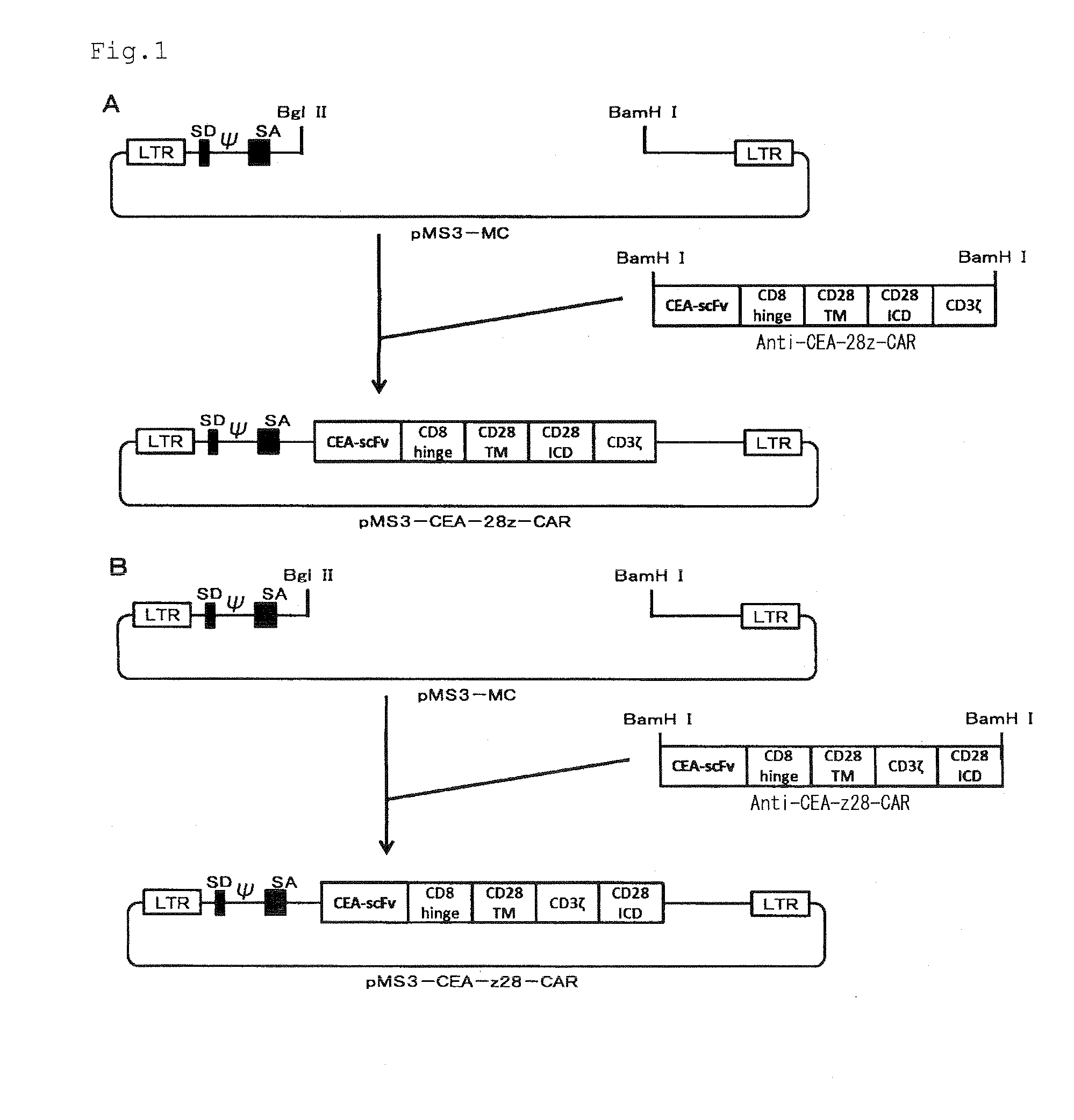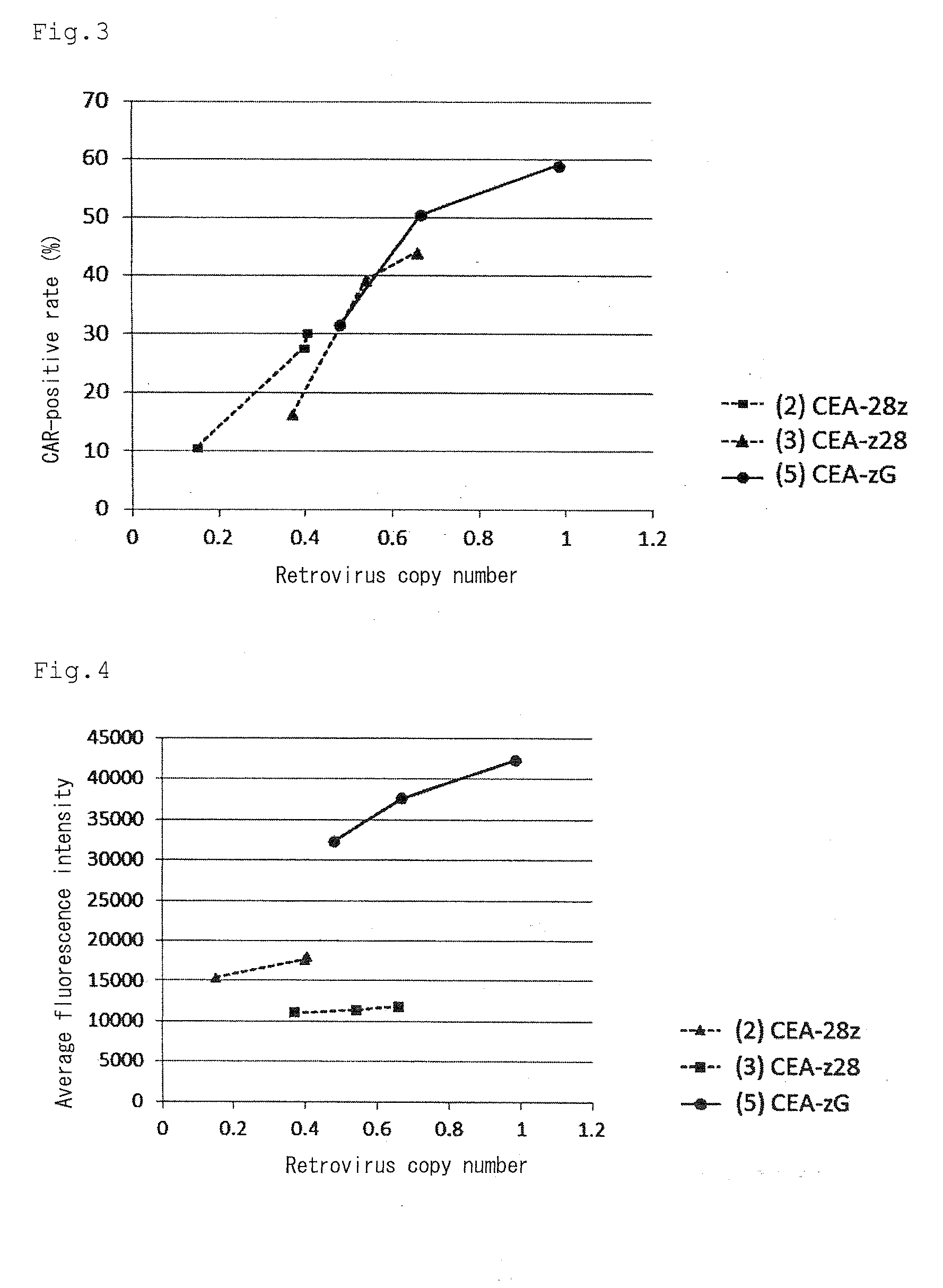Chimeric antigen receptor
a chimeric antigen receptor and nucleic acid technology, applied in the direction of immunoglobulins, peptides, drugs, etc., can solve the problems of uniform stimulation of t cells, limited intracellular domain of costimulatory molecules used in the second and third generation cars, etc., and achieve high expression amount of chimeric antigen receptors in the cell and high cytotoxic activity.
- Summary
- Abstract
- Description
- Claims
- Application Information
AI Technical Summary
Benefits of technology
Problems solved by technology
Method used
Image
Examples
example 1
Preparation of Anti-CEA-CAR Expression Vector
[0094]First, PCR was performed with a 3MSCV5 primer shown in SEQ ID NO: 1 and a 3MSCV3 primer shown in SEQ ID NO: 2 using pMSCVneo (manufactured by Clontech) as a template, to amplify a MSCV3′ LTR site. The amplified fragment thus obtained was cut with restriction enzymes XhoI and EcoRI, and cloned into a XhoI-EcoRI site of a pM vector [pM vector described in Gene Therapy vol. 7, pp. 797-804 (2000)] to prepare pMS-MC. Further, a pMEI-5 vector (manufactured by TAKARA BIO INC.) was cut with restriction enzymes MluI and XhoI, and inserted into a MluI-XhoI site of the pMS-MC to prepare pMS3-MC. The pMS3-MC contains 5′LTR derived from MMLV, SD derived from MMLV, ψ derived from MMLV, SA derived from a human EF1α gene, and 3′LTR consisting of a U3 region derived from MSCV and the other regions derived from MMLV, in this order from the 5′ end.
[0095]As shown in FIGS. 1A and 1B, an artificial synthetic gene of a base sequence shown in SEQ ID NO: 3 ...
example 2
Preparation of CAR Expression Vector Carrying GITR Gene
[0096]An artificial synthetic gene shown in SEQ ID NO: 5 was prepared. This artificial synthetic gene encodes a GITR transmembrane domain having an amino acid sequence shown in SEQ ID NO: 27 and a GITR intracellular domain having an amino acid sequence shown in SEQ ID NO: 28. Using this artificial synthetic gene as a template, PCR was performed with a 28TM-G-F primer shown in SEQ ID NO: 6 and a G-z-R primer shown in SEQ ID NO: 7 to obtain an amplified DNA fragment A, PCR was performed using with a z-G-F primer shown in SEQ ID NO: 8 and a G-MC-R primer shown in SEQ ID NO: 9 to obtain an amplified DNA fragment B, PCR was performed with a 28SD-G-F primer shown in SEQ ID NO: 10 and a G-z-R primer shown in SEQ ID NO: 7 to obtain an amplified DNA fragment C, PCR was performed with a hinge-G-F primer shown in SEQ ID NO: 11 and a G-28SD-R primer shown in SEQ ID NO: 12 to obtain an amplified DNA fragment D, and PCR was performed with a z...
example 3
Preparation of Retrovirus Solution
[0104]Escherichia coli JM109 was transformed with the plasmid vectors prepared in Examples 1 and 2 to obtain transformants. Plasmid DNAs harbored by these transformants were purified using QIAGEN Plasmid Midi Kit (manufactured by Qiagen), and subjected to the following steps as DNAs for transfection.
[0105]The DNA for transfection thus prepared, and a pGP vector and a pEeco vector contained in Retrovirus Packaging Kit Eco (manufactured by TAKARA BIO INC.) were transfected into a 293T cell. This manipulation was performed according to the product protocol of the kit. From each of the transformed cells thus obtained, a supernatant containing an ecotropic virus was obtained, and filtered with a 0.45 μm filter (Milex HV, manufactured by Millipore). Using this supernatant, a PG13 cell (ATCC CRL-10686) was infected with the ecotropic virus by a method using polybrene. A culture supernatant of the cell thus obtained was recovered, and filtered with a 0.45 μ...
PUM
| Property | Measurement | Unit |
|---|---|---|
| pH | aaaaa | aaaaa |
| fluorescence intensities | aaaaa | aaaaa |
| structure | aaaaa | aaaaa |
Abstract
Description
Claims
Application Information
 Login to View More
Login to View More - R&D
- Intellectual Property
- Life Sciences
- Materials
- Tech Scout
- Unparalleled Data Quality
- Higher Quality Content
- 60% Fewer Hallucinations
Browse by: Latest US Patents, China's latest patents, Technical Efficacy Thesaurus, Application Domain, Technology Topic, Popular Technical Reports.
© 2025 PatSnap. All rights reserved.Legal|Privacy policy|Modern Slavery Act Transparency Statement|Sitemap|About US| Contact US: help@patsnap.com



